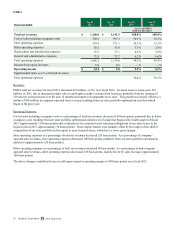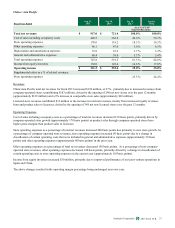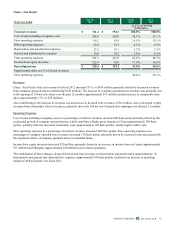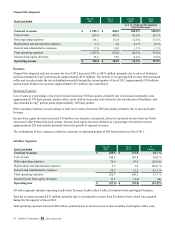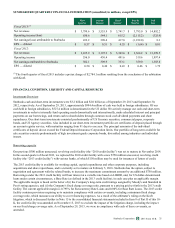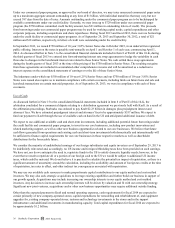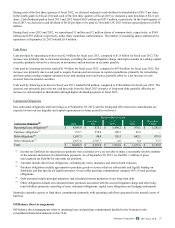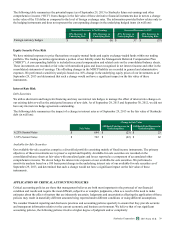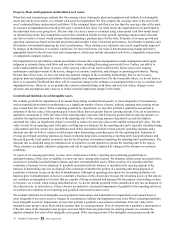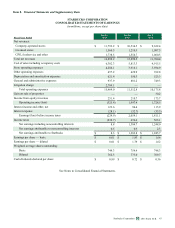Starbucks 2013 Annual Report Download - page 44
Download and view the complete annual report
Please find page 44 of the 2013 Starbucks annual report below. You can navigate through the pages in the report by either clicking on the pages listed below, or by using the keyword search tool below to find specific information within the annual report.
36
Under our commercial paper program, as approved by our board of directors, we may issue unsecured commercial paper notes
up to a maximum aggregate amount outstanding at any time of $1 billion, with individual maturities that may vary, but not
exceed 397 days from the date of issue. Amounts outstanding under the commercial paper program are to be backstopped by
available commitments under our credit facility. Currently, we may issue up to $729 million under our commercial paper
program (the $750 million committed credit facility amount, less $21 million in outstanding letters of credit). The proceeds
from borrowings under our commercial paper program may be used for working capital needs, capital expenditures and other
corporate purposes, including acquisitions and share repurchases. During fiscal 2013 and fiscal 2012, there were no borrowings
under the credit facility or commercial paper programs. As of September 29, 2013 and September 30, 2012, a total of $21
million and $18 million, respectively, in letters of credit were outstanding under the credit facility.
In September 2013, we issued $750 million of 10-year 3.85% Senior Notes due in October 2023, in an underwritten registered
public offering. Interest on the notes is payable semi-annually on April 1 and October 1 of each year, commencing April 1,
2014. As discussed further in Note 3 to the consolidated financial statements included in Item 8 of Part II of this 10-K, during
the third quarter of fiscal 2013 we entered into forward-starting interest rate swap agreements to hedge the variability in cash
flows due to changes in the benchmark interest rate related to these Senior Notes. We cash settled these swap agreements
during the fourth quarter of fiscal 2013 at the time of the pricing of the $750 million in Senior Notes. The resulting net gains
from these agreements are included in accumulated other comprehensive income and will be amortized as a reduction to
interest expense on the consolidated statements of earnings over the life of these Senior Notes.
The indentures under which our $550 million of 10-year 6.25% Senior Notes and our $750 million of 10-year 3.85% Senior
Notes were issued also require us to maintain compliance with certain covenants, including limits on future liens and sale and
leaseback transactions on certain material properties. As of September 29, 2013, we were in compliance with each of these
covenants.
Use of Cash
As discussed further in Note 15 to the consolidated financial statements included in Item 8 of Part II of this 10-K, the
arbitration concluded for a commercial dispute relating to a distribution agreement we previously held with Kraft. As a result of
the arbitration proceedings, Starbucks was ordered to pay Kraft $2.23 billion in damages plus prejudgment interest and
attorneys' fees. We have estimated prejudgment interest and attorneys' fees to be approximately $557 million. We expect to
fund our payment to Kraft through the use of available cash on hand in the US and anticipated additional issuance of debt.
We expect to use additional available cash and short-term investments, including additional potential future borrowings under
the credit facility and commercial paper program, to invest in our core businesses, including new product innovations and
related marketing support, as well as other new business opportunities related to our core businesses. We believe that future
cash flows generated from operations and existing cash and short-term investments both domestically and internationally will
be sufficient to finance capital requirements for our core businesses in those respective markets as well as shareholder
distributions for the foreseeable future.
We consider the majority of undistributed earnings of our foreign subsidiaries and equity investees as of September 29, 2013 to
be indefinitely reinvested and, accordingly, no US income and foreign withholding taxes have been provided on such earnings.
We have not, nor do we anticipate the need to, repatriate funds to the US to satisfy domestic liquidity needs; however, in the
event that we need to repatriate all or a portion of our foreign cash to the US we would be subject to additional US income
taxes, which could be material. We do not believe it is practical to calculate the potential tax impact of repatriation, as there is a
significant amount of uncertainty around the calculation, including the availability and amount of foreign tax credits at the time
of repatriation, tax rates in effect, and other indirect tax consequences associated with repatriation.
We may use our available cash resources to make proportionate capital contributions to our equity method and cost method
investees. We may also seek strategic acquisitions to leverage existing capabilities and further build our business in support of
our growth agenda. Acquisitions may include increasing our ownership interests in our equity method and cost method
investees. Any decisions to increase such ownership interests will be driven by valuation and fit with our ownership strategy.
Significant new joint ventures, acquisitions and/or other new business opportunities may require additional outside funding.
Other than the expected payment to Kraft and normal operating expenses, cash requirements for fiscal 2014 are expected to
consist primarily of new company-operated stores; capital expenditures for remodeling and refurbishment of, and equipment
upgrades for, existing company-operated stores; systems and technology investments in the stores and in the support
infrastructure; and additional investments in manufacturing capacity. Total capital expenditures for fiscal 2014 are expected to
be approximately $1.2 billion.
2013 10-K
Starbucks Corporation Form


